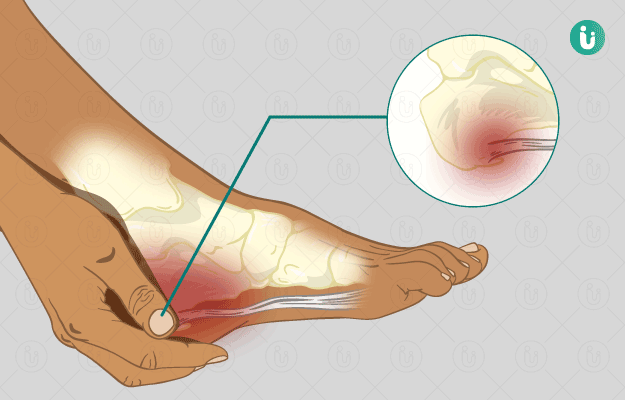What is heel spur?
Heel spur is defined as an abnormal bony growth in the heel of the foot resulting in pain while walking, standing, or running. This outgrowth develops as a result of calcium accumulation due to damage or injury to the muscles, tendons, or ligaments, which protect your heel from stress or pressure.
It is commonly seen in middle-aged adults than children. It affects men and women equally frequently. According to an Indian study, the incidence of heel spur is found to be 59% among those with pain in the heel.
What are its main signs and symptoms?
The primary symptom reported is heel pain. But heel spurs are rarely responsible for causing pain by themselves. You may feel the pain due to compression of these bony outgrowths on the nearby tissues. Sharp pain is experienced in the first morning steps after getting up from bed, which gradually reduces. You may also have swelling and tenderness in the heel.
The symptoms are similar to those of plantar fasciitis, a condition of inflammation or injury to the connective tissue, which extends from the heel to toe.
What are its main causes?
Plantar fasciitis is the main cause of heel spur in most cases. In case of an injury to the plantar fascia, the connective tissue that protects your foot from strain, takes more time to heal, small bone formation starts. Other causes of heel spur are:
- Excess strain on muscles and ligaments of the feet
- Overstretching
- Physical activities in athletes, such as running and jumping
- Extended or long periods of standing
- Individuals with flat heels or high arch
- Unsteady walking
- Wearing of improper fitting shoes
- Overweight
- Pregnancy
- Diseases such as arthritis and diabetes
How is it diagnosed and treated?
If you have the symptoms of heel spur, your doctor will first examine your feet and take a medical history to determine the cause. An x-ray will then be recommended. However, tests, such as MRI and ultrasounds, are rarely recommended.
Medications, such as anti-inflammatory drugs, are prescribed to relieve pain. Other self-care options in pain management by heel spur are as follows:
- Taking adequate rest
- Applying ice pack to the painful heel
- Wearing shoes that fit properly
- Avoiding barefoot walks on a hard surface
- Performing muscle stretching exercise
- Losing weight if overweight
Surgery is the last option when pain relief is not achieved with non-surgical methods.

 Doctors for Heel Spur
Doctors for Heel Spur  OTC Medicines for Heel Spur
OTC Medicines for Heel Spur



















